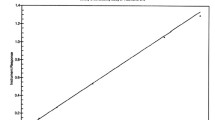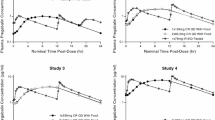Summary
The aim of this study was to evaluate the pharmacokinetic profile after single and multidose oral administration of a new slow-release theophylline formulation and the bioavailability at steady-state during two dosing intervals (5th and 8th day) in 6 healthy subjects. A dose of 6 mg/Kg (capsules) was given for the single and at fixed 12 h intervals during 10 days for the multidose schedule. Theophylline kinetics were best described by a one-compartment open model. After single dose the elimination half-life was 7.22 ± 2.36 h, the Vd area/F was 0.50 ± 0.07 1/kg and the total clearance/F was 0.86 ± 0.24 m l/Kg/min, which was similar to results reported in other studies. Steady-state plasma levels were predictable from the kinetic data and were reached between the 4th and 6th dose, falling within the therapeutic range throughout the dosing interval. The percentage of fluctuation remained constant during both intervals, around 33 and 35% respectively. Bioavailability parameter values for the two intervals showed no differences either in extent or in rate. A circadian rythm was confirmed with the mean morning trough values significantly greater than the corresponding mean evening values. From these results it may be concluded that the formulation studied produces few fluctuations of theophylline levels during the 12 h interval between both administrations, thus permitting a good therapeutic cover in chronic therapy.
Similar content being viewed by others
References
Hendeles L., Weinberger M. and Wyatt R. (1978): Guide to oral theophylline therapy for treatments of chronic asthma. Ann. J. Dis. Child. 132, 876–880.
Hendeles L. and Weinberger M. (1983): Theophylline. A “state of the art”. Review. Pharmacotherapy 3, 2–44.
Hendeles L., lafrate P. and Weinberger M. (1984): A clinical and pharmacokinetic basis for the selection and use of slow release theophylline products. Clin Pharmacokinet. 9, 95–135.
Francis R.J. (1984): ELSMOS -an extended least squares modelling system in Fortran IV for mini or microcomputer implementation. Comput. Prog. Biomed. 18, 43–50.
Nie N.H., Hull C.H., Jenkins J.G., Steinbrenner K. and Bent D.H. (1983): Statistical Package for the Social Sciences: SPSS-X, User’s Guide. McGraw-Hill (ed). SPSS Inc., New York.
Jackson Sh.D. and Wright J.M. (1983): Sustained serum theophylline concentrations during chronic twice daily administration of a slow release preparation. Eur. J. Clin. Pharmacol. 24, 205–208.
Halkin H., Mazar A., Almog S. and Schnaps Y. (1982): Components of variability in serum theophylline concentrations during maintenance therapy with a sustained release formulation. Eur. J. Clin. Pharmacol. 23, 225–228.
Koëter G.H., Jonkman Jh.G., de Vries K., Schoenmaker R., Greving J.E., de Zeeuw R.A. (1981): Pharmacokinetics of sustained release theophylline in low and high multidose regimens. Br. J. Clin. Pharmacol. 12, 647–651.
Henneghien C., Remade P., Bruart J. and Souckheer J. (1985): A double blind crossover study of the steady state plasma pharmacokinetics of two sustained release theophylline preparations. Acta Ther. 11, 363–373.
Weinberger M., Hendeles L., Wong L. and Vaughan L. (1981): Relationships of formulations and dosing interval to fluctuation of serum theophylline concentration. J. Pediatr. 49, 145–152.
Cotgreave Ian. A. and Caldwell J. (1985): Comparative pharmacokinetics of theophylline and ethylenediamine following single and repeated doses of a susteined release aminophylline preparation to volunteers. J. Pharm. Pharmacol. 37, 618–621.
Lesko J.L., Brousseau D., Canada A.T. and Eastwood G. (1980): Temporal variations in trough serum theophylline concentrations at steady state. J. Pharm. Sci. 69, 358–359.
Taylor D.R., Duffin D., Kinney C.D. and McDevitt D.G. (1983): Investigation of diurnal changes in the disposition of theophylline. Br. J. Clin. Pharmacol. 16, 413–416.
Segrestaa J.M., Dahan R., Houlbert D., Caulin C., Ronnel A. and Abella M.L. (1984): Chronopharmacokinetics in steady state of a sustained release theophylline. Thérapie. 39, 633–637.
Pierre M.V., Spino M., Isles A.F., Tesoro A. and MacLeod S.M. (1985): Temporal variation in the disposition of theophylline and its metabolites. Clin. Pharmacol. Ther. 38, 89–95.
Author information
Authors and Affiliations
Rights and permissions
About this article
Cite this article
Torrent, J., Izquierdo, I., Barbanoj, M.J. et al. Theophylline pharmacokinetics following single and repeated administration of slow-release capsules. Eur. J. Drug Metab. Pharmacokinet. 13, 225–230 (1988). https://doi.org/10.1007/BF03190083
Received:
Issue Date:
DOI: https://doi.org/10.1007/BF03190083




